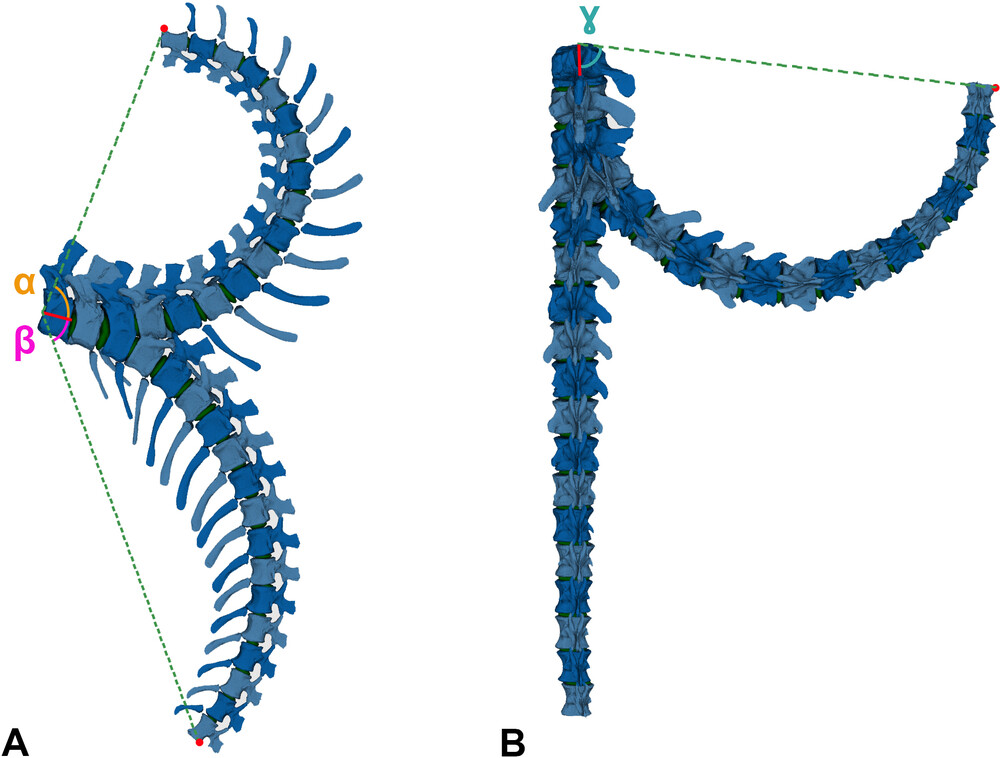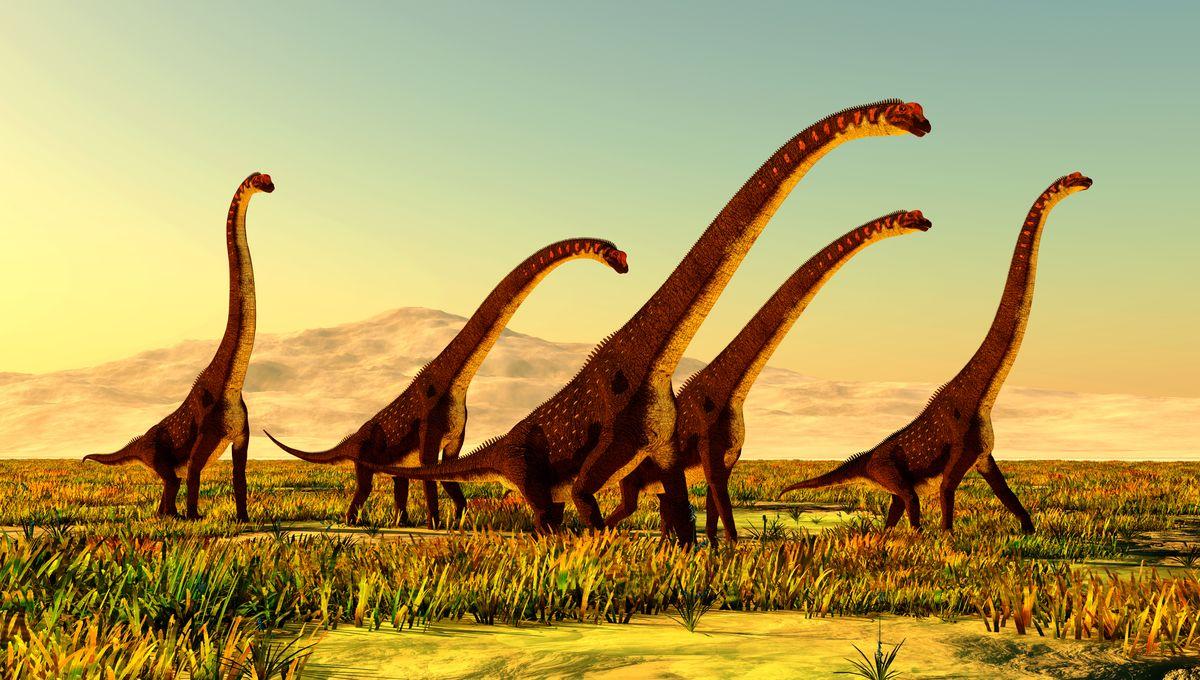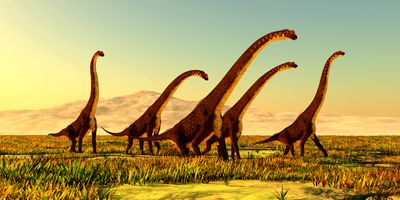Our planet was, for hundreds of millions of years, dominated by one group of animals only: dinosaurs. They lived everywhere from Antarctica to the equator; from western Europe to southeastern Australia, exploiting almost every terrestrial niche and quite a few aerial ones to boot.
The rest of this article is behind a paywall. Please sign in or subscribe to access the full content. It’s strange, then, that we know so little about them. Oh, sure, we know how they looked – more or less, anyway – and what they ate, stuff like that. But how did they act? How did they move? A new study suggests the answer isn’t quite what we were taught – at least in the case of the gargantuan Giraffatitan. Imagine a sauropod – the often gigantic, always long-necked, herbivorous herd animals of the dinosaur kingdom. Chances are, most of the detail is on that head and neck area – but what’s going on behind? If you’re getting most of your information from places like Jurassic Park or Dinosaur Train, the answer to that may be “not much”. “We have known for decades that dinosaurs kept their tails at rest in a position relatively parallel to the ground, contrary to the classic view of them dragging their tails along the ground,” Verónica Díez Díaz, a senior postdoctoral fellow in vertebrate palaeontology at the Museum für Naturkunde Berlin’s Leibniz Institute for Evolution and Biodiversity Science, and lead researcher on the study, explains to IFLScience. “However, until relatively recently, the tail was depicted as an almost static element with little movement.” But that’s odd, right? After all, a tail is as much a part of an animal’s body as its limbs – it can be prehensile, grasping objects and aiding with tasks like climbing, or it can be used for balance. If nothing else, it can serve as a useful signal for a creature’s emotional state, like the wagging tail of a dog or the flick of a cat rapidly losing its patience. Why, then, should dinosaurs be so different? “The main use of the tail was to propel the hindlimb, i.e., to move the animal,” says Díez Díaz. “But they probably also used it as a tool for defence and communication with other animals.” “However, it is important to note that behaviour generally does not fossilise,” she adds. In other words, we can’t know for sure how and why these long-extinct animals used their tails – but what we can say is how they could have. Díez Díaz and her colleagues discovered that the Giraffatitan would have had an astonishing range of possible movement, able to curl up like a malamute’s or bend down towards the dino’s ankles. The two views, lateral (from the side) on the left and dorsal (from above) on the right, of how the tail could move. Image credit: Díez Díaz et al., Royal Society Open Science 2025 (CC BY 4.0) “The sauropod tail needs to provide a stable basis” for the dinosaur who wears it, the paper concludes, but they “are more than just appendages that help sauropods move their limbs and balance their bodies.” “In fact, they are complex modular structures with an array of biomechanical and behavioral functions, which likely played a significant role in the development and evolutionary success of this group of animals.” Palaeontology is far from being an ‘antiquated’ or ‘becoming extinct’ science. Verónica Díez Díaz So, where do these claims come from? Díez Díaz certainly has the credentials to make them: she’s been studying the back end of Giraffatitan for nearly a decade now, carefully chipping away at how the sauropod’s tail could and would move in real life. It’s been a long process, beginning with looking at the traces left on bones by musculature and tendons – these “are generally very well fossilised,” Díez Díaz explains – and comparing that with what we know about extant species like crocodiles and birds. More recently, it’s involved cutting-edge reconstructions and computer models of the titanic appendages. “Palaeontology is far from being an ‘antiquated’ or ‘becoming extinct’ science,” the researcher tells IFLScience. “[It] is in fact very much up to date with technological developments, bringing us ever closer to understanding what extinct animals were like, how they moved and behaved.” Much of the work behind the new study was actually carried out years ago, for a paper published in 2020. It was then that Díez Díaz and her colleagues completed a detailed analysis of Giraffatitan’s tail, using computer-aided modeling to reconstruct the back half of its tail and concluding, for example, that the entire appendage must have weighed around 2,500 kilograms (5,512 pounds) – about the same as an adult male rhinoceros. Reminder: that’s just the tail. And, Díez Díaz explains, “now that we have [that] data […] we can apply them in biomechanical simulations.” So what do you do once you’ve figured out the secrets of the Giraffatitan tail? For Díez Díaz, the work never stops: “We have several caudal series of sauropods from the Late Jurassic of Tendaguru,” she tells IFLScience, referring to the fossil-rich rock formation in southeastern Tanzania where Giraffatitan was found. “We are following the same methodologies with them,” she says, “[and] with the final results, we will also be able to better understand that ecosystem and the interrelationships between all those sauropods.” For me, the most exciting thing is to ‘bring these fossil remains to life’. Verónica Díez Díaz Having built up this picture of the tail mechanics, the team can also infer much more about how the beasts moved and behaved. Using these results, for example, will allow the researchers to model how fast the dinosaur could move – a statistic we already have from fossilized foot tracks, but that recreating independently will help validate, Díez Díaz says. And that’s not all: “These simulations will also help us to better understand the metabolic needs of these dinosaurs and the distances travelled in their migrations,” she explains. “As is always the case in palaeontology, we will never be able to achieve a 100 percent accurate reconstruction,” she says, “but thanks to more innovative methodologies and biomechanical simulations, we are getting closer and closer to reality.” Like any of us lucky enough to live out what is many kids’ dream job, though, the main draw of this research for Díez Díaz isn’t so much the academics. It’s the experience. “For me, the most exciting thing is to ‘bring these fossil remains to life’,” she tells IFLScience. “I began my studies more than 20 years ago by going to fossil sites to extract bones, which I would later describe and use to create new species of dinosaurs. But it is one thing to see those bones isolated in museum collections, and quite another to be able to create musculoskeletal reconstructions and perform simulations in which these reconstructions move and walk.” The study is published in Royal Society Open Science.The tale of the tail

Unraveling the story
The future of the past




